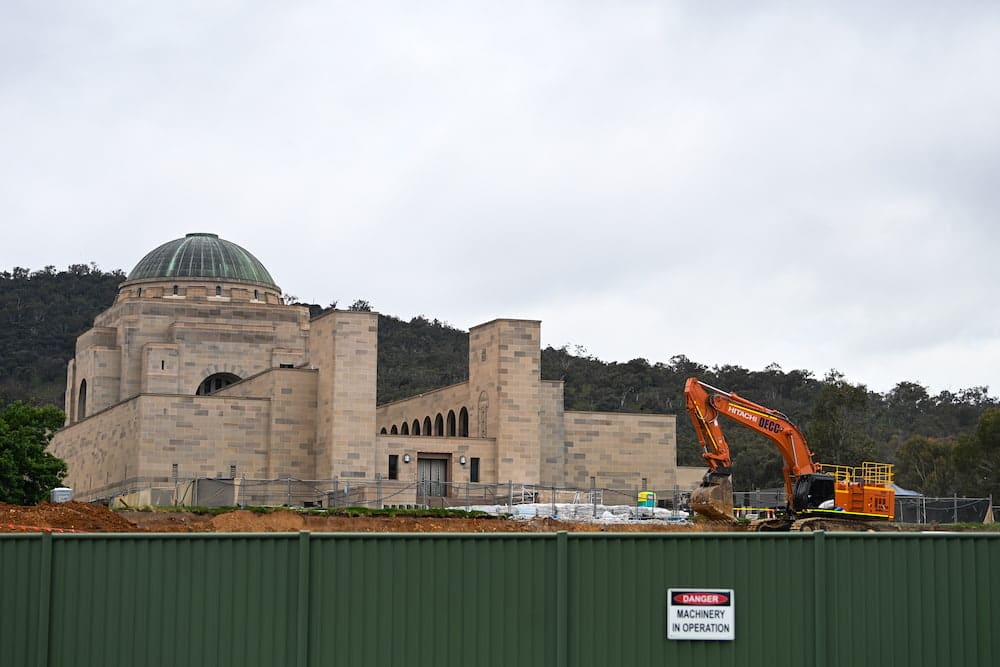The National Capital Authority has ticked off the final three packages for the Australian War Memorial redevelopment – but architects, politicians, and defenders of the heritage building are ‘ticked off’ in quite another sense. They argue that the NCA’s decision was undemocratic, and their methodology selective.
“This approval was a foregone conclusion from the day this redevelopment project was first announced,” said Clare Cousins, former National President of the Australian Institute of Architects and spokesperson for the #handsoffAnzacHall campaign.
“It has made an absolute mockery of public consultation and due process each and every step along the way and at every approval ‘gateway’, which was really nothing more than a smokescreen for a pre-determined outcome.”
On Sunday, the NCA gave its approval to the packages of works for final stages of the $500 million redevelopment: a new southern entrance, extending the C.E.W. Bean Building, and a new Anzac Hall and glazed link to the main building.
The AWM states these will provide equitable and weatherproof access to the main building and galleries, increase seating capacity to the parade ground, and realign the parade ground to enhance the relationship with the main building grid geometry; create more space for the Memorial’s archives; and increase exhibition space to display large objects, and create a more visitor-friendly connection between the main building and Anzac Hall.
“This is a very significant milestone,” said AWM director Matt Anderson. “Modern veterans … are now one step closer to having their stories told in the new galleries.”
Consistent with the National Capital Plan, or a betrayal?
The NCA found the proposal was “not inconsistent” with the National Capital Plan.
“The proposed works have been designed in a manner to strengthen the geometry of the Griffins’ Plan, with the alterations strengthening built elements of the site and the Land Axis,” a statement read. “The proposal is an evolution of the AWM which is widely accepted as a successful reinterpretation of the 1918 Griffin Plan.”
The Australian Institute of Architects vehemently disagreed.
“As the Institute highlighted in our submission, the National Capital Authority’s crucial role is to ensure that all development within significant areas of the national capital is consistent with the National Capital Plan,” Ms Cousins said. “It is clear that the AWM Redevelopment Project, including “early works” that are already approved and underway, are inconsistent with the National Capital Plan.”
Similarly, Greens Federal candidate Tim Hollo said the NCA’s decision “stands as a deep betrayal of the National Capital Plan and the Griffin Plan, changing the symbolic role of Canberra in national life”.
“Changing this building, with its central position in the city, from a space of reflection on the tragedy of war into one designed to showcase weapons and military hardware, is a symbolic shift our city is going to have to grapple with in the years to come,” Mr Hollo said.
Stopping the War Memorial expansion was a key plank of Mr Hollo’s campaign last election.
The Anzac Hall demolition
The redevelopment project has been dogged by controversy from the outset; Anzac Hall, the AWM’s award-winning, multi-million-dollar exhibition space, was knocked down after only 20 years, to the outrage of architects and heritage enthusiasts.
Mr Anderson explained at the time that the Hall was not big enough; there was not enough space to expand galleries, or display bigger aircraft and vehicles; and there was not enough space for visitors.
Labor MP David Smith, a member of the Federal Parliament’s Public Works Committee, had earlier recommended the government should consider other approaches, such as developing the AWM Treloar Technology Centre, in Mitchell, for $100 million – only a fifth of the $498.7 million to build the new Anzac Hall.
Mr Smith said he had expected to ask the NCA about the timeframe for approvals at public hearings this Thursday.
“This approval has short circuited those questions, but is not unexpected,” he said.
Consultation “very selective”, say Heritage Guardians
The NCA said its approval followed a six-week community consultation; of the 587 submissions received from across Australia, 73 per cent of respondents supported the proposed works. In regional towns, support rose to 86 per cent, but fell to 63 per cent in capital cities. Majority support was found in each state, although just 41 per cent of the 112 ACT respondents indicated support.
Dr David Stephens, of the Heritage Guardians, a group opposed to the redevelopment, said that by their count, 76 of the 413 published submissions compared the works with the Plan – and he reckoned 42 of these were against the works. Most were also only one line long, and several were cut-and-paste submissions. (The Heritage Guardians’ Excel analysis is available here.)
The NCA, Dr Stephens continued, seemed to have forgotten that on the equivalent consultation on the early works, 590 out of 601 opposed the proposed works; the NCA downplayed it by saying 590 “expressed concern” about some or all of the works.
“They’re very selective in the way they use information that they’ve gleaned,” he said. “It’s just simplistic and crude to say 73 percent support it, particularly when they downplay the numbers game the other way.”
The Australian Institute of Architects was also critical. “Widespread, well-documented community concern from right around Australia opposing everything from the cost of the project to the demolition of the award-winning Anzac Hall has been completely disregarded, further undermining people’s trust in government and public institutions’ capacity to independently, fairly and accountably assess proposals,” Ms Cousins said.
Mr Hollo said the NCA must be reformed and democratized, “to ensure Canberrans have a say in the shape and nature of the city we live in”. He promised the Greens would have more to say about this in the new year.
- With AAP: Alex Mitchell in Canberra
Get all the latest Canberra news, sport, entertainment, lifestyle, competitions and more delivered straight to your inbox with the Canberra Daily Daily Newsletter. Sign up here.



